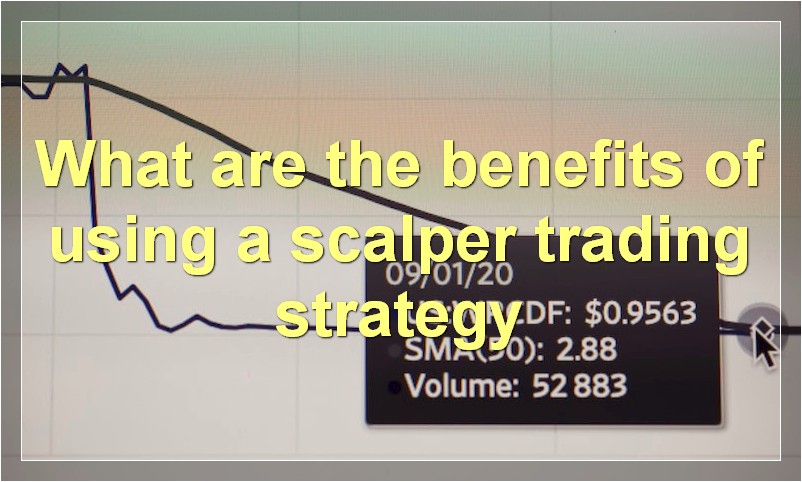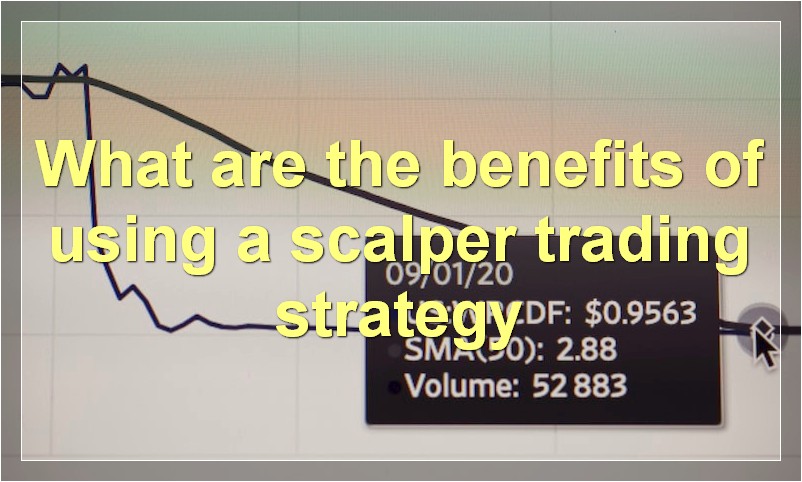Are you looking to make some quick money? Or are you hoping to take your investing to the next level? If so, then scalping might be the trading strategy for you. Scalping is a high-frequency trading strategy that can be used to make small but consistent profits. But before you start scalping, it’s important to understand the pros and cons of this strategy. In this article, we’ll give you an overview of scalper trading strategies and how you can make them work for you.
What is a scalper trading strategy
A scalper trading strategy is a popular technique used by day traders to make money in the stock market. The basic idea behind scalping is to buy a stock at a low price and sell it at a higher price, pocketing the difference. Scalpers typically hold their positions for a very short period of time, often just a few seconds or minutes, and then quickly exit the trade.
While scalping can be a profitable strategy, it does come with some risks. Because scalpers are looking for very small profits, they are often trading with very tight stop-losses, which means that a small move in the wrong direction can quickly erase all of their gains. Additionally, because they are holding their positions for such a short period of time, they may also be more prone to making impulsive decisions and letting their emotions influence their trading.
If you’re interested in trying out scalping as a trading strategy, it’s important to first test it out on a demo account so that you can get a feel for how it works and whether or not it’s right for you.
What are the benefits of using a scalper trading strategy

Scalping is a trading strategy that seeks to profit from small price changes in a security. A scalper will enter and exit trades multiple times throughout the day in an attempt to profit from small price movements. Scalpers typically trade with a very short time frame, such as 1-5 minutes, and use a large amount of leverage in order to make profits.
While scalping can be a profitable trading strategy, it does come with some risks. First, because scalpers are looking for small price movements, they are often trading with very tight stop losses. This means that a small price movement against the scalper can result in a large loss. Second, because scalpers are often trading with large amounts of leverage, they can also experience large losses if the market moves against them.
Despite these risks, scalping can be a profitable trading strategy for those who are able to manage their risk effectively. Those who are new to scalping should approach the strategy with caution and always use stop losses to protect themselves from large losses.
What are some of the risks associated with scalper trading strategies
There are a few risks associated with scalping trading strategies. The first is that it can be difficult to execute the strategy properly, especially if you are new to trading. If you don’t have the proper experience or knowledge, you might end up losing money instead of making a profit. Additionally, scalping generally requires a higher level of risk tolerance than other types of trading strategies. This is because you are typically holding your positions for a very short period of time and thus have less time to make up for any losses. Finally, scalping can be quite stressful and time-consuming, so make sure you are prepared for that before you start using this strategy.
How can I implement a scalper trading strategy in my own trading
Scalping is a trading strategy that seeks to make small but consistent profits in the market. A scalper will typically enter and exit the market multiple times throughout the day, looking to make small profits from each trade.
If you are interested in implementing a scalper trading strategy in your own trading, there are a few things you will need to do. First, you will need to find a market that is suitable for scalping. This means finding a market that is highly liquid and has tight spreads. Some good markets for scalping include the forex market and certain futures markets.
Once you have found a suitable market, you will need to develop a trading strategy that you feel comfortable with. There are many different scalping strategies out there, so it is important to find one that suits your own trading style. Once you have developed a strategy, you will need to backtest it to ensure that it is effective.
Once you have a strategy that is profitable, you can begin implementing it in your own trading. Remember to always use risk management when scalping, as the market can move against you quickly and cause losses.
What are some common mistakes made when using scalper trading strategies
When it comes to scalping, many traders make the mistake of thinking that all they need to do is place their orders and then wait for them to be executed. However, this is not the case, and if you want to be successful at scalping, you need to be actively involved in the market, monitoring your positions and making sure that your orders are filled.
Another common mistake made by scalpers is over-leveraging their positions. While leverage can help you boost your profits, it can also lead to heavy losses if the market moves against you. As a result, it is important to use leverage wisely and only take on as much risk as you are comfortable with.
Finally, another mistake often made by scalpers is failing to use stop-loss orders. While it is possible to make money without using stop-losses, they can help to limit your losses if the market moves against you. As such, it is always a good idea to have a stop-loss in place when scalping the markets.
How do I know if a scalper trading strategy is right for me

When it comes to trading, there is no one-size-fits-all approach. Some people prefer to buy and hold onto their investments for the long term, while others take a more active approach and trade frequently. Scalping is a trading strategy that falls into the latter category.
So, how do you know if scalping is right for you? Here are a few things to consider:
1. Do you like to be in control of your trades?
With scalping, you are in charge of when to enter and exit a trade. This can be appealing for those who like to have control over their investments.
2. Do you have the patience for short-term trades?
Scalping trades usually last for a shorter period of time than other strategies, so you need to be comfortable holding your position for only a short while.
3. Do you have the stomach for quick changes in price?
Since scalping involves taking small profits on many trades throughout the day, it also means that you will experience more quick changes in price. If this doesn’t bother you, then scalping could be a good fit.
4. Are you okay with missing out on bigger moves?
Scalpers generally miss out on the large, long-term trends since they are focused on smaller moves. So if you are looking to ride a big wave, scalping may not be right for you.
5. Do you have the capital to support multiple positions?
Scalpers often take multiple positions at once, so you need to have enough capital to support this strategy.
These are just a few things to consider when trying to decide if scalping is right for you. Ultimately, the best way to find out is to test it out with a demo account and see how it goes.
What are some other popular trading strategies besides scalping
There are a number of other popular trading strategies besides scalping. Some of these include day trading, swing trading, and position trading.
Day trading is a strategy where traders look to take advantage of short-term price movements in the market. This can be done by buying and selling securities within the same day. Swing trading is a strategy that involves holding a position for a period of time and then selling it when the price swings in the desired direction. Position trading is a strategy where traders hold a position for a longer period of time, usually months or years.
Each of these strategies has its own advantages and disadvantages. Day trading can be very risky, but it can also lead to quick profits. Swing trading can be less risky than day trading, but it can also take longer to see profits. Position trading is the least risky of the three, but it can also take the longest to see profits.
Which strategy is best for you will depend on your goals, risk tolerance, and time frame. If you are looking to make quick profits, day trading may be the best strategy for you. If you are willing to wait a bit longer for profits, swing trading or position trading may be better suited for you.
How can I find more information about scalper trading strategies
If you’re interested in scalper trading strategies, there are a few things you can do to find more information. First, consider talking to a financial advisor or broker. They may be able to provide you with some basic information or refer you to someone who specializes in this type of trading. You can also search online for forums or websites that discuss scalper trading strategies. This can be a good way to get tips and advice from other traders who have experience with this type of trading. Finally, consider reading books or articles on the subject. There is a lot of information available on scalper trading strategies, and reading can help you learn more about the different approaches and techniques that are used.
What are some expert tips for successfully implementing a scalper trading strategy
There is no one-size-fits-all answer to this question, as the best scalper trading strategy will vary depending on the trader’s individual goals and objectives. However, there are a few general tips that can help increase the chances of success when implementing a scalper trading strategy:
1. Make sure you have a clear understanding of what you’re trying to achieve. Scalping strategies can be used for many different purposes, so it’s important to have a clear goal in mind before starting to trade.
2. Start with small position sizes. Scalping involves taking many small profits, so it’s important to not risk too much capital on each trade.
3. Use stop-loss orders. Stop-loss orders can help limit losses if a trade goes against you, and they can also be used to lock in profits on winning trades.
4. Be patient. Scalping requires patience and discipline, as it can often take time to find good trading opportunities.
5. Have a plan. A well-defined trading plan can help keep emotions in check and make it easier to stick to your trading strategy.
Is there a downside to using a scalper trading strategy
A scalping trading strategy is a short-term trading strategy where a trader seeks to profit from small price changes in a security. Scalpers trade frequently, holding their positions for only a short time before selling. While a scalper trading strategy can be profitable, there are also some potential downside risks to using this strategy.
Some of the risks associated with scalping include: getting caught in a trend reversal, being subject to wider spreads, and having difficulty exiting a position. Additionally, because scalpers trade so frequently, they may incur higher transaction costs which can eat into their profits. Finally, scalpers need to have a very tight risk management strategy in place to avoid losing all of their capital if the market moves against them.

